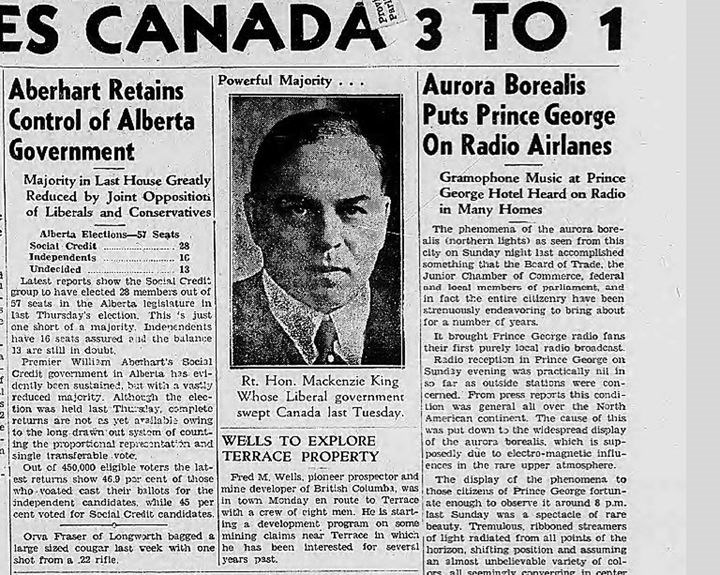This week in Prince George history, June 12-18:
June 14, 1921: Prince George residents wanting a glass of near beer had until midnight to get it before the city's jitney bars -bars selling nonalcoholic drinks - were shut down. The Citizen reported.
"Under the terms of the Government Liquor Act the hour of midnight tonight marks the closing-down of all the near beer bars in the city and the discontinuance of the wholesale traffic conducted by the representatives of brewers," The Citizen reported. "In the city about fourteen jitney bars and four clubs are affected by the new law as well as two wholesalers."
Although no provisions had been made for a government liquor store in Prince George, there would be no extensions provided for near beer sellers, said Brittania Brewery representative William Blair.
"If I had any hogs, I'd feed it to them," Blair said. "It's great stuff for hogs, but it won't be any good for sale."
Karl Anderson, representative of Cascade - the other near beer wholesaler in Prince George - said wholesalers were caught holding now unsellable stock.
"It is all right for the dealers in Vancouver, where they can order from day to day but up here we have to order a carload at a time. I shall lose about $300 on draught beer alone."
All signs advertising bars, saloons or near-beer sales were required to be removed by the end of the day, under the law.
Under the legislation, only government vendors could sell any beverage described as beer, or any other name used to describe malt or brewed liquor.
The government was expected to introduce legislation allowing bars to sell beer later that year, The Citizen reported.
"In this city the liquor board (is) considering the leasing of a premises known as the Great West Pool Room," The Citizen reported.
Another location was under consideration, but no plans for liquor sales in the city had been confirmed as of The Citizen's report.
The Government Liquor Act marked the end of five years of prohibition in B.C.
Canada's brief flirtation with prohibition during the First World War largely came to an end by the early 1920s - although P.E.I. would stay a dry province until 1948.
In 1921, Prince George had a population of 2,053 people, according to B.C. government statistics. It's hard to believe that a town that size sustained 14 bars and four clubs that could only sell nonalcoholic beer - that's one bar for every 114 people - not counting the blind pigs - illegal bars - that were discussed in a past edition of this column.
There were more bars operating in the city in 1921 than there are today, with a population of approximately 72,000. If there was as many bars per capita in the city today, Prince George would have more than 630 bars and pubs.
I guess folks back then were awfully thirsty.
June 14, 1916: Good roads in the region are making travel by motor car quick and easy, The Citizen reported.
"Leaving Vanderhoof at 1 p.m. on Sunday last, George Snell and John Bronger made the trip to Prince George in six hours and forty minutes in Mr. Snell's Ford car," The Citizen reported. "Included in this period was an hour's stop at Bednesti Lake, the home of the speckled beauties of the piscatorial tribe, where they captured in less than an hour thirty specimens of Dave Perkins' wards."
"Mr. Snell states that the road to Vanderhoof is now in excellent condition, and the trip can be made a pleasant one, besides giving the traveller a knowledge of the rich and varied resources of the country not gained in any other way."
According to the Canadian Automobile Association's TripTik Travel Planner, the driving distance from Vanderhoof to Prince George is 99.5 kilometres, with an average driving time of one hour and nine minutes.
A Rand McNally and Company map of B.C. from 1916 shows a road from Vanderhoof to Prince George following pretty much the same route used by Highway 16 today - running parallel to the train route. Assuming the distance was more or less the same as today, Snell and Bronger averaged just over 17.5 km/h on their trip, excluding the hour of fishing - not exactly a blistering pace.
How slow is 17.5 km/h? Well, to qualify for the men's marathon at the 2016 Olympics, runners have to post a minimum time of two hours and 19 minutes, requiring an average speed of more than 18 km/h.
Thankfully for those going on road trips this summer, modern cars will get you there faster than you could run.
To explore 100 years of local history yourself, visit the Prince George Citizen archives online at: pgc.cc/PGCarchive. The Prince George Citizen online archives are maintained by the Prince George Public Library.



